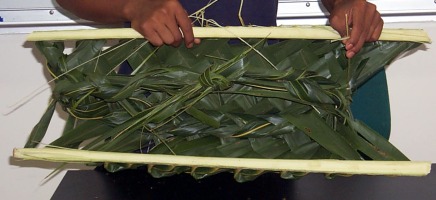SC/SS 115 Ethnobotany Test 2 Spring 2003 • Name: ________________
- List some characteristics of a hunter-gatherer society
- List some characteristics of an agrarian society
- Why are foreign starches such as rice thought to contribute to diabetes while local starches such as taro and breadfruit do not?
- __ Foreign starches contain more calories.
- __ Foreign starches contain less calories.
- __ Foreign starches cause a faster rise in blood sugar levels.
- __ Foreign starches cause a slower rise in blood sugar levels.
- __ Foreign starches contain more complex starches.
- What is fafa ?
- What is nohpwei ?
- Merfylinta brought a special food from Kapinga culture. What was it made from?
- What is opot ?
- What is lak' ?
- The food presentations included a number of presentations on preserving breadfruit. What are the reasons that all Pacific Island tropical cultures preserve breadfruit? That is, why is it preserved or for what is it preserved?
- Presentations included mention that some of the foods being described were often brought to weddings. Why do all cultures on the planet bring food to weddings? That is, what is the significance of this?
- Use a sketch to illustrate the difference between an opposite and an alternate arrangement of leaves on a stem.
- Sketch a cordate leaf, a palmate leaf, and an elliptical leaf.
- There will be leaf shapes in the room provided by your instructor. Write the shapes below.
- "Upon arrival in the new land fruit the size of a child's head were planted but they never grew. " is a legend of the Pacific Islanders of what island?
- In lecture and presentations we learned that both Fijian and Mwokillese culture have gender specified roles when building a canoe. What are the roles, that is, who builds what parts?
- In Nukuoro we learned that a wedding is not complete without a particular gift. What gift did we learn must be presented according to tradition?
- Who gives the gift in the above question and to whom do they give it?
- Give the name of the following item in Kosraen, Pohnpeian, Chuukese, and Yapese:

- On the essay questions keep your writing clear and legible. Take your time and do your best to use correct spelling and grammar.
Essay question: Many traditional cultures, including those of Micronesia, have generally abandoned their material culture practices. Traditional homes have given way to cement cinder block houses, canoes have been replaced by fiberglass outboard motor boats and airplanes, and few young Micronesians tattoo themselves from head to foot. While people hold on to their language, their traditional medicinal plants, and their traditional foods, material culture seems to be intentionally jettisoned. Young men wear stylish closed foot athletic shoes, women adopt western clothing, and everyone wears sunglasses. Is preservation of material culture important to keeping a culture alive or is material culture relatively unimportant
- Essay question: Which is the most important food plant for your people and WHY? Be specific in your reasoning, give examples of how and why that food plant is the most important.
